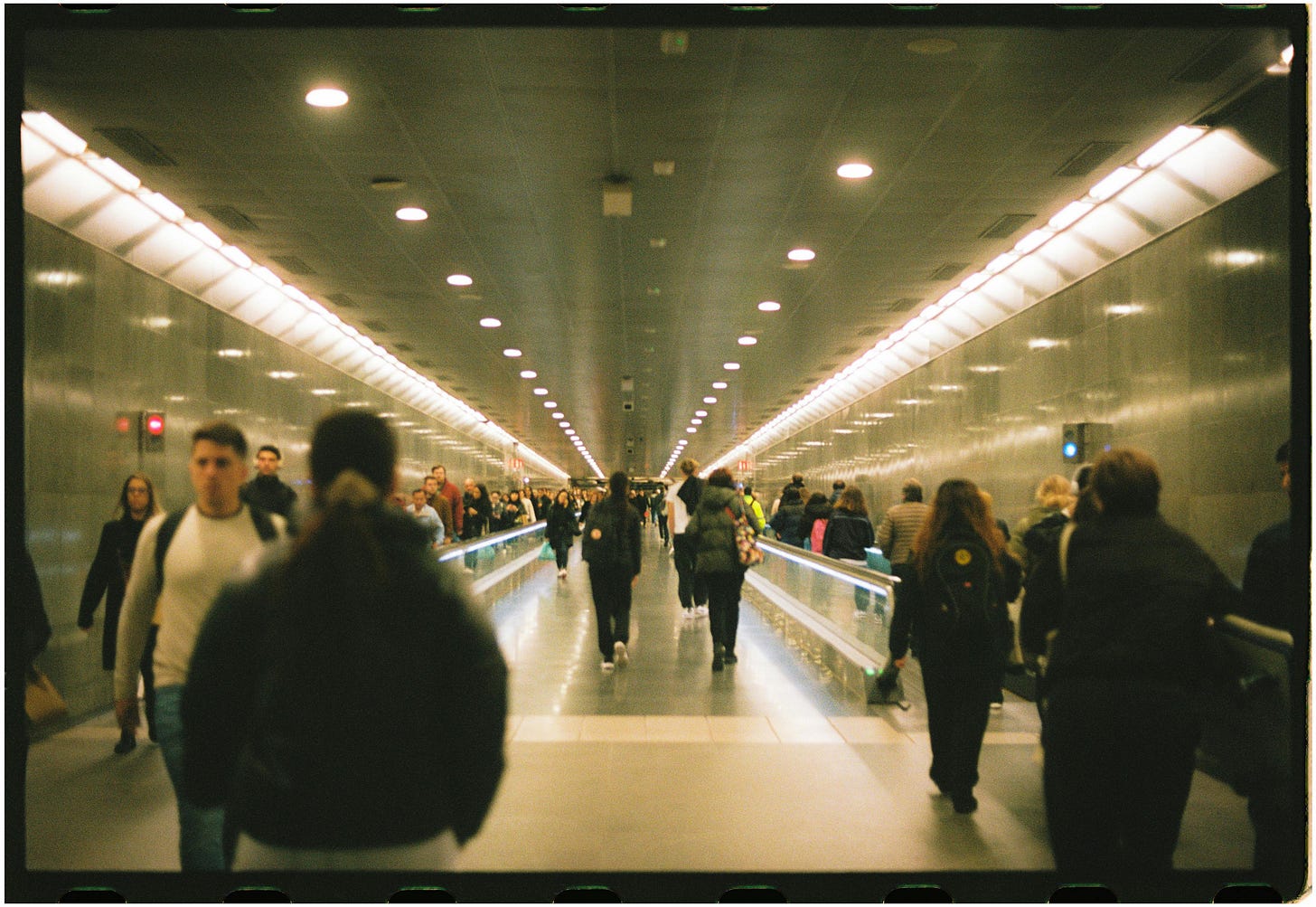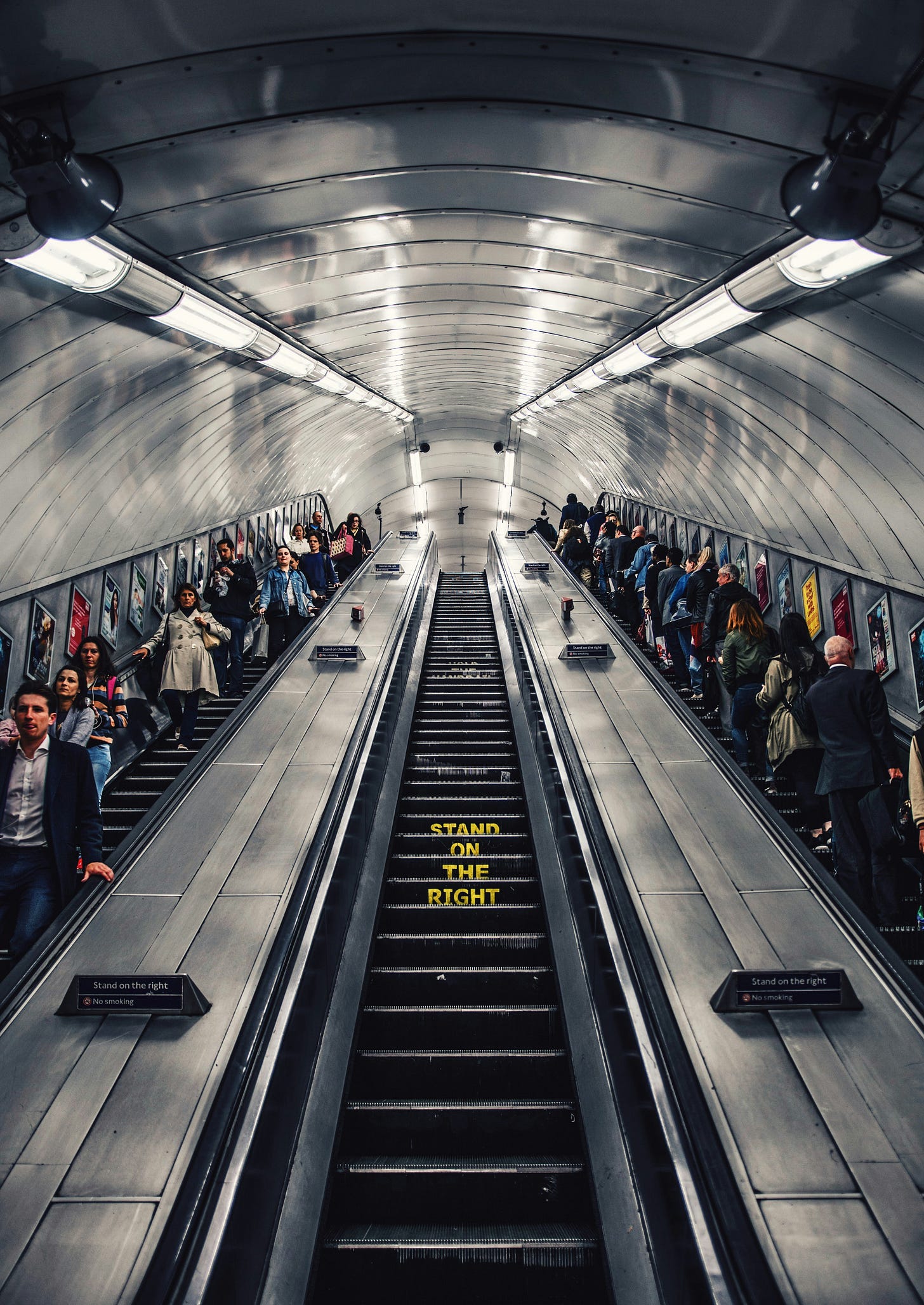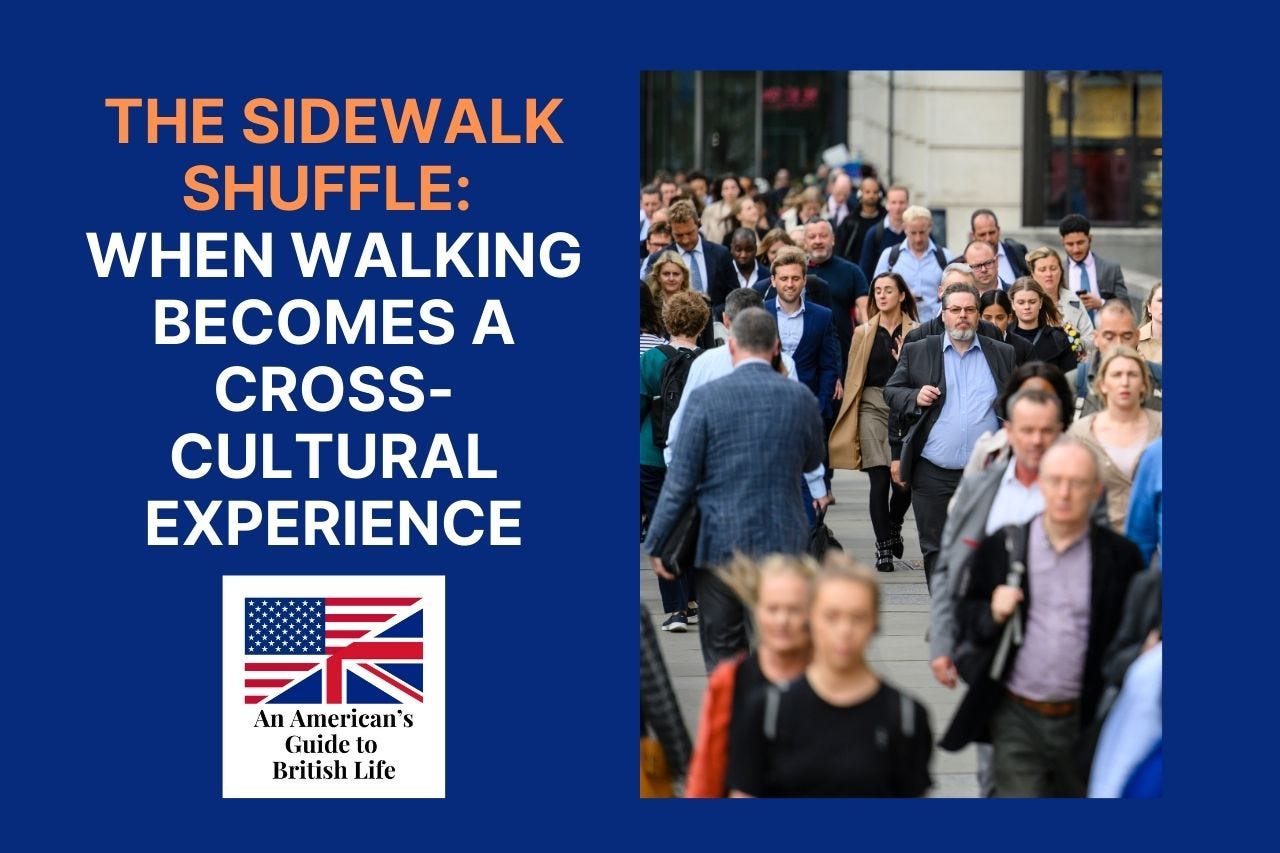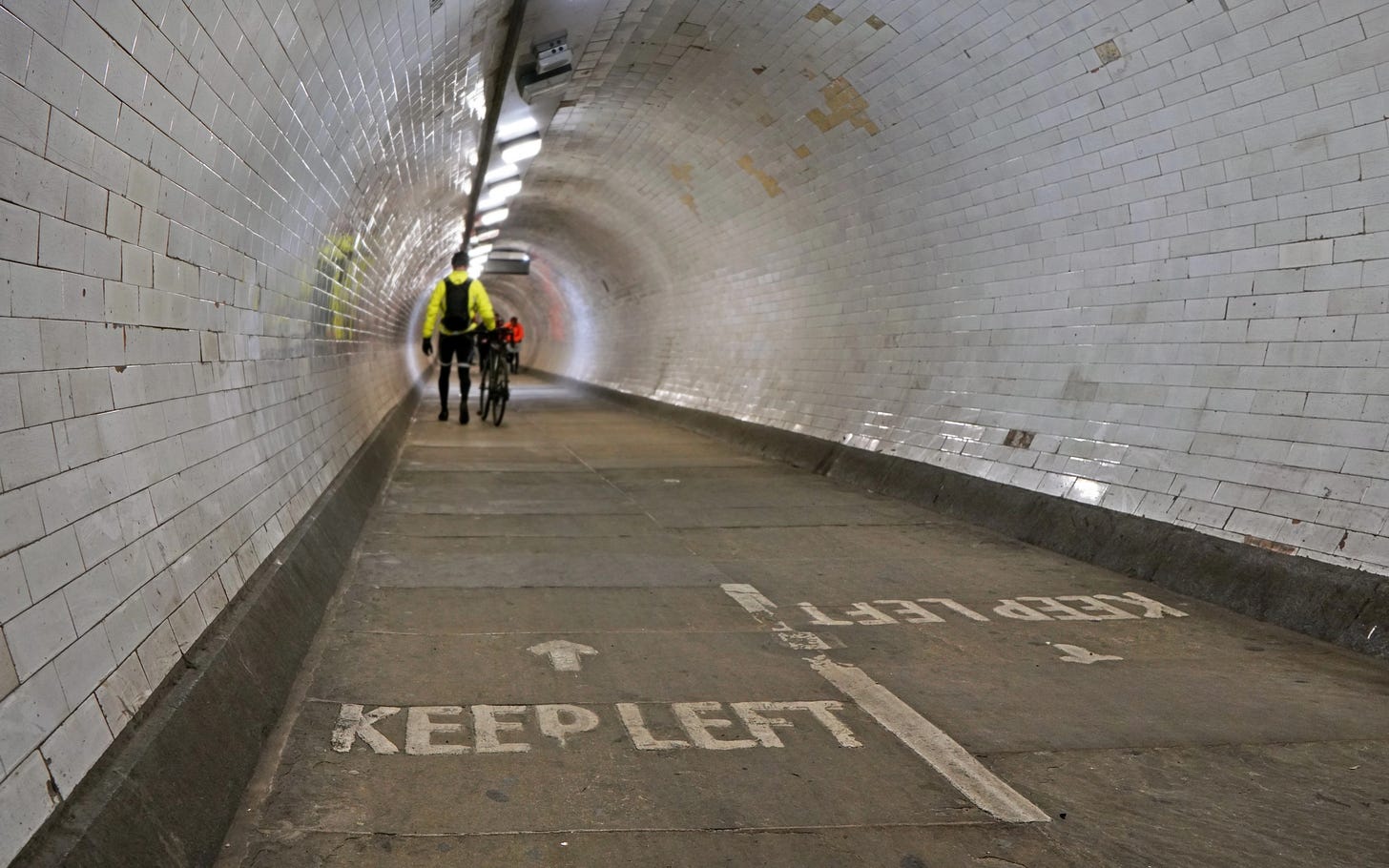The Sidewalk Shuffle: When Walking Becomes a Cross-Cultural Experience
An American's Guide to British Pedestrian Traffic
Welcome to An American's Guide to British Life - my lighthearted celebration of British culture! As an American living in the UK for the past three years, I love exploring the delightful cultural differences and similarities that make life here so interesting. These articles are written with affection and humor, never judgement and always with respect.
I knew about driving on the left side of the road before moving to Britain. I had mentally prepared for that fundamental traffic reversal, reminding myself that the driver sits on the right side of the car and roundabouts flow clockwise.
What I hadn't anticipated was how this left-side orientation would extend far beyond the roadways and into nearly every aspect of daily movement, from crowded city sidewalks to countryside hiking trails.
As a well-traveled American who has visited countries across several continents, I've always been fascinated by these subtle cultural differences in movement patterns. My first inkling of this phenomenon came about 15 years ago during my very first international trip – a 16-hour layover at Heathrow that turned into an impromptu London adventure.
Despite the jet lag, I remember the exhilaration of exploring London for the first time – navigating the Tube, walking around the city center, and experiencing the quintessential thrill of riding a red double-decker bus.
Through the fog of travel fatigue, I noticed something different about how people moved through spaces. The flow of pedestrian traffic felt subtly but persistently "off" from what I was used to, though I couldn't quite articulate why at the time.
Over years of subsequent travel, I began piecing together this pattern: in countries where people drive on the left, pedestrians also tend to keep left.
It remained an interesting curiosity – something I'd notice upon arrival in a new country but would quickly adapt to for short visits. But when I moved to Britain permanently, this subtle directional preference became part of my daily navigation challenge rather than a temporary adjustment.
When you're in a situation where people are moving in both directions, it becomes immediately clear which side of the walkway the majority of people prefer. I consistently find myself instinctively drifting right while most others move left, creating small but noticeable disruptions in the flow.
It's almost entirely subconscious – this tendency to default to one side or the other – and it makes it surprisingly easy to spot visitors who aren't locals.
I was reminded of this again recently when I found myself in Leeds train station during rush hour. Fresh off the train, I found myself swimming upstream against a river of commuters, receiving confused glances and the occasional frustrated sigh. I initially moved to my right out of ingrained habit – the same side I'd automatically take on any American sidewalk or corridor – while everyone else flowed seamlessly along their left.
What I initially observed as a traveler's curiosity had revealed itself as an unspoken but firm cultural rule that would now affect my daily life: in Britain, pedestrian traffic generally keeps to the left.
The Invisible Choreography of Public Movement
Every culture develops its own unwritten rules about public movement – a kind of pedestrian choreography that locals follow without conscious thought. These rules only become visible when broken, usually by foreigners like me who haven't yet learned the local dance steps.
What makes this phenomenon particularly fascinating is how these directional preferences strongly correlate with a country's driving orientation. Studies have consistently shown that people tend to follow the same side preference when walking as they do when driving. The pattern becomes deeply ingrained in our unconscious behavior.
In America, the convention is clear: keep to the right, just like on American roads. This pedestrian pattern extends seamlessly from roadways to sidewalks, shopping mall corridors, airport terminals, and even grocery store aisles. Americans instinctively drift right when approaching others, creating an orderly flow that generally works without anyone having to think about it.
Britain operates on the reverse principle. Here, pedestrians typically keep left, matching the left-side driving pattern on British roads. This left-orientation creates a coherent system across all forms of movement, but it's precisely this coherence that makes it so challenging for visitors from right-oriented countries to adapt.
The preference appears to be both cultural and pragmatic. We're trained from childhood to look in certain directions for oncoming traffic, making some movement patterns feel intuitively safer.
Additionally, our brain seems to transfer the rules of the road to all forms of public movement for consistency's sake. These unconscious patterns become so automatic that overriding them requires deliberate attention – which is why visitors like me often find themselves inadvertently disrupting the flow.
Where You'll Notice the Difference
The left-side pedestrian preference becomes most apparent in crowded or confined spaces where flow patterns matter most:
Train Stations and Airport Terminals

In busy British transport hubs like London King's Cross or Heathrow Airport, the left-side flow is often reinforced with explicit signage. "Keep Left" signs appear on stairways and corridors, sometimes accompanied by painted lines or arrows on the floor.
What fascinates me is how Britons seem to obey these directional suggestions almost universally. In American airports, despite "Keep Right" indicators, there's often a more chaotic flow with people drifting across lanes. The British adherence to these movement patterns reflects a broader cultural respect for queuing and orderly public behavior.
Shopping Centers and Department Stores
British shopping centers (malls) showcase the left-side system particularly well. In multi-level establishments, escalators follow the pattern too – stand on the right, walk on the left (interestingly, this is one area where the pattern matches American convention).
Department store aisles often subtly encourage left-side traffic through store layout and display positioning. I've noticed how British shoppers naturally navigate these spaces by keeping left at intersections and when passing others, rarely colliding despite crowded conditions.
Supermarket Aisles
Perhaps the most everyday manifestation of this directional preference occurs in supermarket shopping. British shoppers typically push their trolleys (shopping carts) keeping to the left side of the aisle. Many larger supermarkets actually design their floor layouts with this flow in mind, positioning special offers and displays to catch the eye of shoppers moving in the expected left-keeping pattern.
During my first few grocery shopping trips, I found myself constantly drawn to the right side of aisles, inadvertently creating mini-traffic jams with oncoming shoppers. Now I've trained myself to naturally drift left, though I still occasionally revert to right-side movement when distracted by an interesting British product I hadn't seen before – like that time I stopped dead in my tracks upon discovering prawn cocktail flavored crisps!
Sidewalks (Pavements)
On British pavements (sidewalks), the left-orientation becomes a bit more fluid but still generally applies. Urban areas with heavy foot traffic demonstrate it most clearly – watch pedestrians in any busy city center or high street, and you'll see most locals instinctively keeping left.
Less crowded suburban pavements show more variation, but the left-side tendency remains, especially when groups approach each other from opposite directions.
One notable exception occurs in heavily touristed areas of London, such as around Westminster, Covent Garden, or the South Bank. In these international hotspots, the traditional left-side pattern sometimes breaks down entirely as visitors from right-walking countries, left-walking countries, and everywhere in between create a more chaotic flow. In these pedestrian melting pots, the only real rule becomes constant vigilance and flexibility!
Staircases
Stairways in public buildings throughout Britain typically follow the left-side rule, with people ascending and descending on the left side of the staircase. This becomes particularly important in subway (tube) stations and other transit facilities where efficient movement prevents dangerous congestion.
Escalator Etiquette

One area where British pedestrian rules can create unexpected confusion for Americans is escalator etiquette. Despite the general "keep left" orientation of British public spaces, the escalator rule is: stand on the right, walk on the left.
London Underground escalators are particularly strict about this convention. Visitors who stand on the left quickly learn their error through the pointed sighs or polite "excuse me" comments from commuters wishing to walk past.
Beyond Urban Centers: The Country Path Experience
What surprised me most was discovering how the "keep left" principle extends into recreational and rural settings. After observing this pattern in busy city locations, I was fascinated to find it followed me into the countryside as well.
On British hiking trails and country paths, the left-side preference generally persists, though with more flexibility than in urban settings. Popular walking routes often see walkers naturally keeping left when passing, particularly on wider trails.
What I found particularly interesting is how British hiking guidebooks and trail etiquette materials rarely mention this directional preference explicitly – it's simply assumed as part of the natural order of things.
My Pedestrian Faux Pas
I've lost count of the number of times I've found myself awkwardly doing the "sidewalk shuffle" – that uncomfortable moment when two people approach each other and both move the same way repeatedly, creating a miniature comedy of errors rather than smoothly passing. It's like an unintentional dance where neither partner knows the steps.
During my first months in Britain, these shuffles happened daily. I'd instinctively move right while the approaching Brit would move to their left (my right), creating an impasse. Then would come the apologetic smiles, the "sorry" reflexes from both sides, and finally a deliberate correction as I remembered to override my American programming.
My British spouse faces the exact opposite problem when we return to the States for visits. After a lifetime of British pedestrian patterns, they instinctively drift to the left in American spaces, finding themselves in awkward back-and-forth standoffs in the middle of grocery store aisles.
During our last visit home, my dad watched this happen repeatedly and chuckled as my spouse unwittingly created these miniature traffic jams. The fascinating part was that my spouse wasn't even aware of their subconscious shift to the left until my dad pointed it out after witnessing several of these mid-aisle shuffles. This unconscious behavior perfectly illustrates how deeply ingrained these movement patterns are within our respective cultures, and how challenging they can be to override even temporarily.
Navigating Cultural Traffic Rules
After months of conscious effort, I finally developed a more automatic left-side pedestrian orientation. It's become part of my British behavioral adaptation, along with understanding that "alright?" is a greeting rather than a genuine inquiry about my wellbeing.
For Americans visiting or moving to Britain, I recommend consciously practicing the left-side pedestrian habit from day one. It helps to look for environmental cues that reinforce the pattern:
Watch the locals: Observe how people queue for service at shops or navigate train platforms.
Look for signage: "Keep Left" indicators provide helpful reminders in many public spaces.
Connect it to driving: Remind yourself that the pattern matches road rules.
Be especially mindful in crowded areas: Tourist destinations and transit hubs require the most careful adherence to keep things flowing smoothly.
Notice ground markings at crossings: At pedestrian crossings throughout Britain, you'll often see "LOOK LEFT" or "LOOK RIGHT" painted on the ground – helpful reminders about which direction traffic will be coming from. These visual cues can also reinforce your pedestrian orientation.
I've found that British people are generally understanding when visitors accidentally disrupt the flow – a confused sidewalk shuffle rarely earns more than a patient smile. However, consistently moving against the natural pattern in crowded spaces can create genuine inconvenience and frustration for those around you.
A Metaphor for Cultural Adaptation
This pedestrian traffic rule has become, for me, a perfect metaphor for the broader experience of cultural adaptation. The pattern is invisible to locals but immediately disorienting to newcomers. It requires conscious effort to override your instincts until eventually, through repetition, the new pattern becomes automatic.
Most importantly, it demonstrates how cultural differences extend far beyond the obvious areas like language, food, or holidays. They permeate the everyday aspects of daily life – even something as seemingly universal as how to walk through a public space.
There's something wonderfully human about how both cultures have developed systems that work perfectly well for their own contexts. Neither approach is inherently superior – they're simply different solutions to the same problem of organizing human movement. What matters isn't which side you walk on, but that enough people agree on a system that allows everyone to navigate shared spaces efficiently.
Now when I return to visit America, I find myself experiencing the reverse confusion, automatically drifting left on sidewalks and causing minor traffic jams back home. These moments of reverse culture shock remind me how thoroughly I've internalized aspects of British life – not just in my conscious thoughts but in the unconscious choreography of my daily movements.
And perhaps that's the true marker of cultural adaptation – not when you can perfectly articulate the differences between two cultures, but when you've internalized the new patterns so deeply that they become your default setting, requiring no conscious thought at all.
Have you experienced pedestrian traffic confusion when traveling abroad? Or noticed other subtle movement patterns that differ between cultures? I'd love to hear your experiences in the comments below.
See you next Sunday!
Marianne






As ever, Marianne, I much enjoyed reading your piece. Something I was taught as a youngster back in the early sixties is that if walking towards a woman, the polite thing for a man to do is to move to the side of the pavement nearest the traffic (so in the UK, adopting the move to the right approach). I still tend to do it, along with opening doors and, when sitting at tables to the side of a restaurant, having my back to the restaurant's centre so that a woman faces it. Oh, and giving up my seat on crowded buses if a woman is standing. I know all these things are of the past, not the done thing now and acknowledge the change in social norms, but also I recognise how such behaviour is still ingrained in me. Old dogs and new tricks, indeed.
Although regarding giving up my seat, I recall being on a bus in Italy not too many years ago and doing that for an older woman. The female partner of a much younger man and several others on the bus admonished the poor chap for not offering his seat to the woman in question. He eventually saved face by insisting I take his seat.
When I moved to the city in the 1970s, I soon learned to perfect what I called my London swerve. It was a manoeuvre an NFL running back would be proud of as they carved their way through a defence(s)e. Quickly cutting to the right or left and 'going for the gap' to avoid dawdling tourists and their propensity to move in any direction or even turn around on their heels without warning.
As for the British tendency to form orderly queues, I remember arriving at Naples (my favourite Italian City) railway station many decades ago to purchase a ticket. Before me was a melee of people clamouring to be the next to get to the ticket seller's window. I soon realised I would have to dispense with my British nature of waiting in line and thus dived into the morass of bodies. While I successfully obtained a ticket, it took me a few hours to overcome the trauma of throwing aside my British etiquette!
One exception to the general left-side preference is that when walking in a road without a pavement (I.e. when sharing the road with vehicles) I was taught to walk on the right of the road, so as to face oncoming traffic.